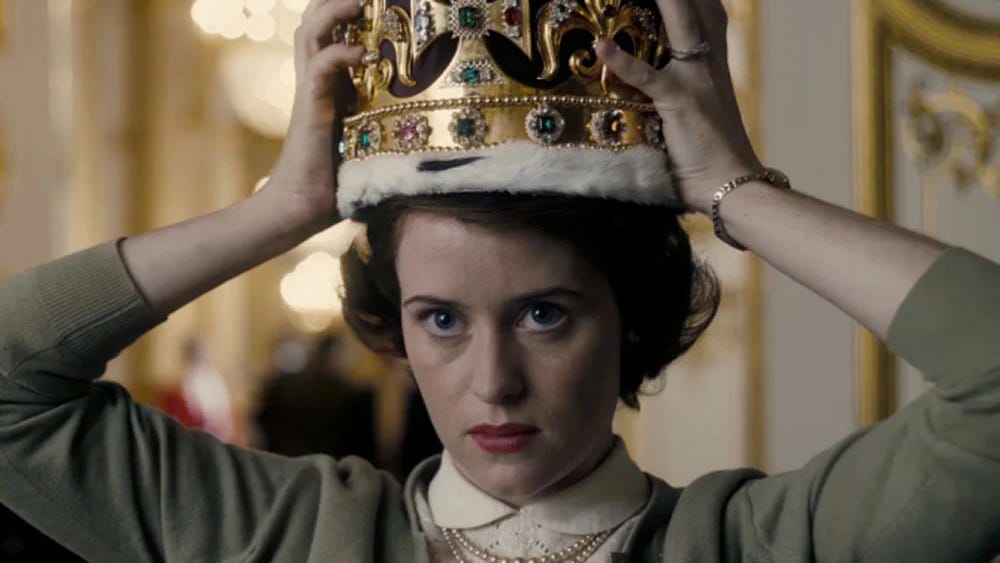I’ve just finished watching The Crown.
Outside of 1) owning a Princess Diana Beanie Baby and 2) experiencing a brief flutter of excitement after barely seeing Queen Elizabeth II exit St. Paul’s Cathedral in 2012, I never had much interest in the British Royal family. When The Crown came out in 2016, I was a holdout, despite my husband watching the series and consequently begging to vacation in Scotland.
So perhaps it was QEII’s recent passing that spurred me on to finally watch the acclaimed series. (Or perhaps it was the winter darkness and being homebound in the evenings with two young children.) Either way, it’s been quite entertaining quite thought-provoking - the perfect content duo.

I actually watched the series out of order, beginning with season 4 (because that is where Princess Diana’s storyline begins) before watching season 5, and then looping back to the beginning with seasons 1, 2, and 3.
A recent episode I watched (S3E3, “Aberfan”) features an interesting string of dialogue between Queen Elizabeth and Prime Minister Harold Wilson that I instantly knew would serve as the perfect introduction to this post’s main idea.
Context: The Welsh mining village of Aberfan suffers a deadly collapse of a colliery soil tip that kills 144 people - most of them children attending school. Queen Elizabeth, despite urging from the government and her family, does not immediately visit the village to offer consolation. When she does make her way to Aberfan several days after the tragedy, she struggles to express an authentic display of emotion to the residents or the swarm of photographers who’ve ascended to document the symbolic trip.
Toward the end of the episode, Queen Elizabeth reflects upon the experience with Prime Minister Wilson, leader of the Labor* party. (*this detail is important later!)
She laments, “The people of Aberfan deserved a prompt response. They didn’t get one. They deserved a display of compassion, of empathy, from their Queen.”
The Prime Minister assures her, “And they got it yesterday.”
“They got nothing—“ The Queen replies curtly. “I dabbed a bone-dry eye, and by some miracle, no one noticed.”
A long pause.
Queen Elizabeth has just brought into focus the idea that everything communicates.
And, what’s more — that these communications, these symbols, these transmissions of meaning, these utterances of beliefs — often act to intentionally persuade, even when they are contrived and formulated and inauthentic.
The conversation continues.
Queen Elizabeth explains how she often fails to adequately display emotion. She wonders if there is something wrong with her that she would have to transfigure her outward state in a way that doesn’t necessarily match her inner state.
The Prime Minister sucks in his breath.
“These meetings are confidential, yes?”
The Queen nods.
The Prime Minster takes this as permission to continue.
“I have never done a day’s manual work in my life. Not one. I am an academic, a privileged Oxford don, not a worker.”
The Queen stares.
Wilson continues:
“I don’t like beer. I prefer brandy.
I prefer wild salmon to tinned salmon.
Chateaubriand to steak and kidney pie…
And I don’t like pipe smoking.”

Queen Elizabeth clearly wonders to what point the previous assertions will conclude.
“I far prefer cigars,” the Prime Minister continues.
“But cigars are a symbol of capitalist privilege.
So, I smoke a pipe, on the campaign trail and on television.
Makes me more… Approachable. Likable.”

In his advice, the Prime Minister explains how the division of preferred objects serve as markers of social class; that objects as seemingly straightforward and innocent as beer, salmon, and tobacco could signify in-group (or out-group) belonging. That the objects one associates themselves with could reflect one’s values and sense of personal identity.
This idea has been thoroughly explicated by thinkers such as Pierre Bourdieu (Distinction), Jean Beaudrillard (The System of Objects) and Dick Hebdidge (Subculture: The Meaning of Style). But one doesn’t need to read these books to sense the truth in Prime Minister Wilson’s message.
We are all excellent readers of signs. And in today’s world of self-branding and performance, we are also excellent conveyers of sign meaning. Even when we don’t know it.
And this brings us to back to the idea that:
Everything communicates.
The thing said. The thing not said.
The presence. The absence.
The image chosen. The curvature of the font. The color. The contrast. The music in the background.
The chosen drink (beer, not brandy). The type of fish (tinned, not wild). The form of steak (kidney pie, not Chateaubriand). The way you smoke (never a cigar, always a pipe).
The tear shed, or not.

Everything conveys meaning.
Everything communicates… something.
When you see the world in this way, you’ll never be content with the obvious. Instead, you’ll develop an urge to scratch at the the surface for deeper, hidden meanings.
—
In conclusion (for now - because there is so much more to say on this topic)
We are inundated with visual messages (over 50k advertising messages a week!!!) and our brains interpret these messages much faster (60k times faster!!!) than visual text alone. It now goes beyond media literacy and has become survival knowledge to 1) be aware of, and 2) critically interpret the swirl of messages around you.
Next Tuesday I’ll be sharing a tutorial on how to conduct semiotic visual analysis on static images - breaking down the various “hidden” sign meanings embedded in advertising image and text in a systematic way. (The logic also extends to dynamic video content.) With a little practice, you’ll never be able to look at marketing the same way — and that’s my intent.
Enjoyed this post? Check out Everything Communicates, Part 2 and Part 3.





Sarah, I am very much enjoying your writing and perspective “Everything communicates” True.
So true…Everything communicates! Great read !